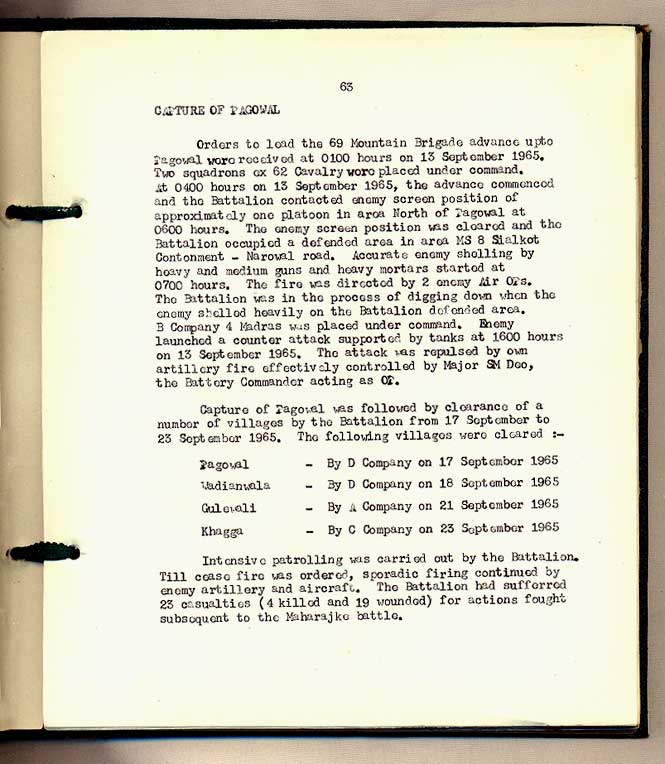
|
From The Black Pom Pom
( A SHORT HISTORY OF THE MADRAS REGIMENT
- 1758 - 1972
Lt. Col Jitendra Kumar
- 3 MADRAS |
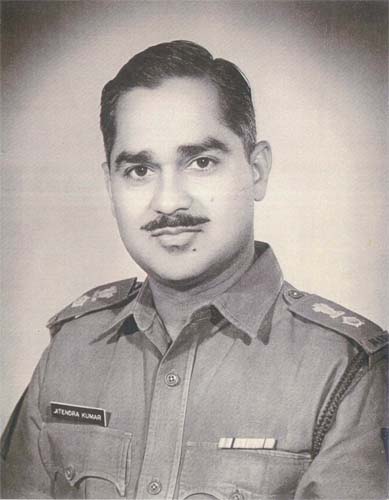 |
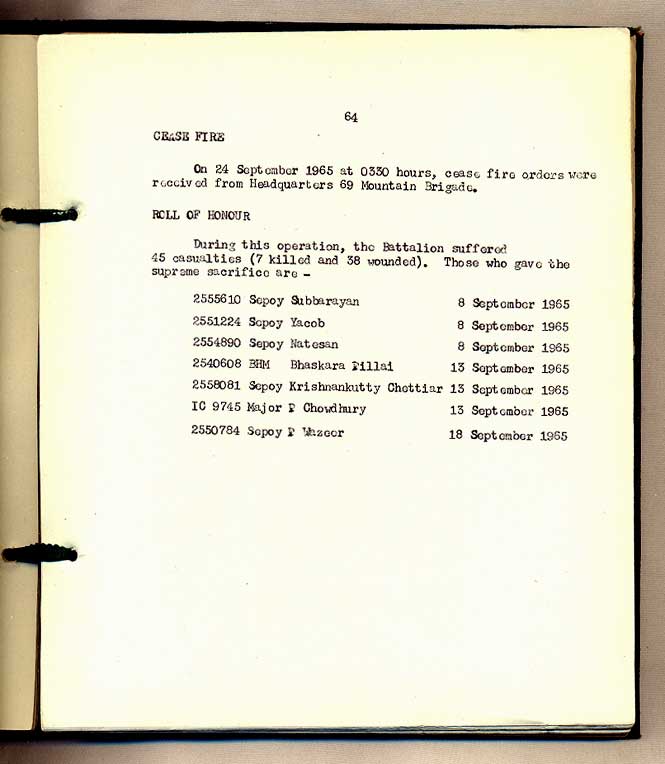

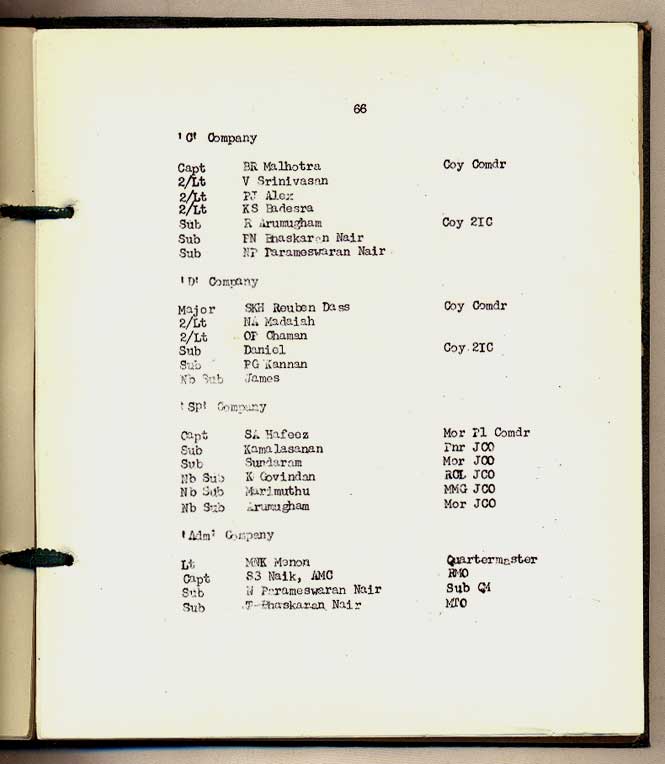

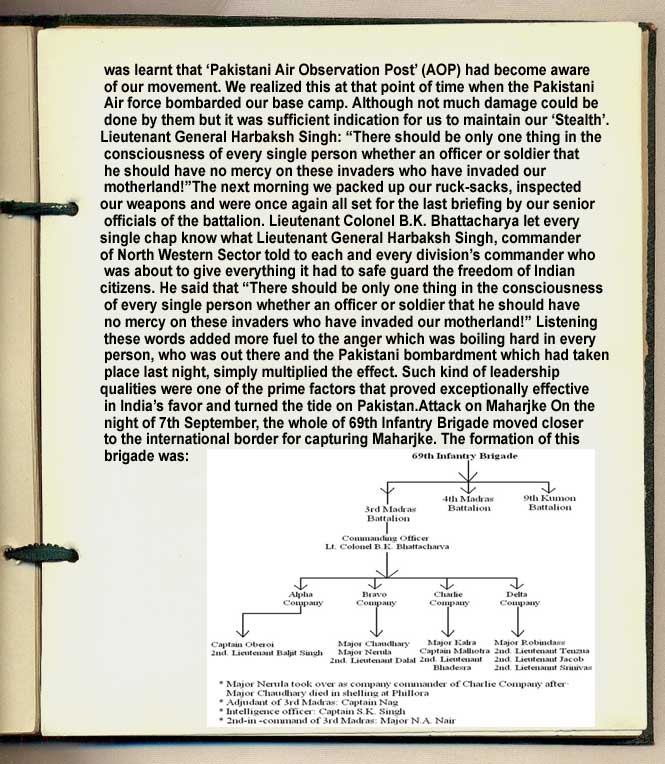
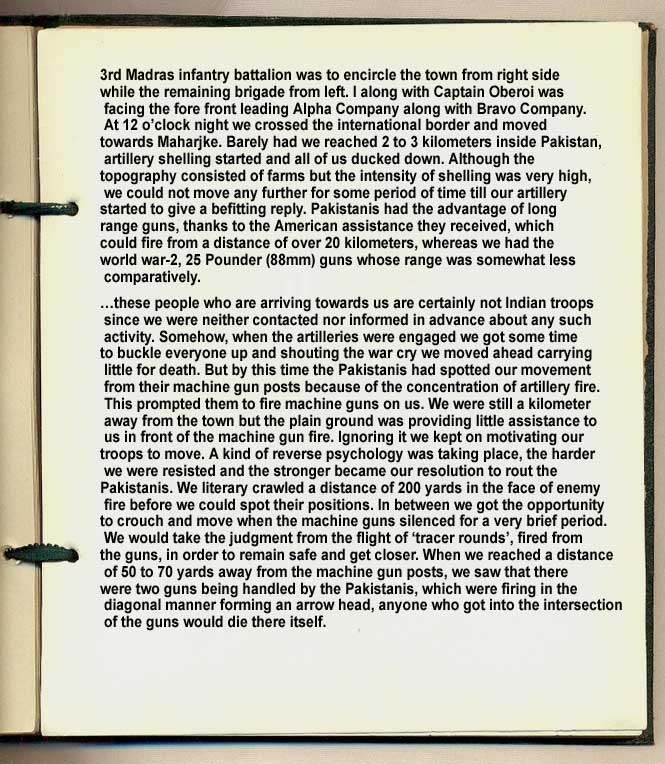
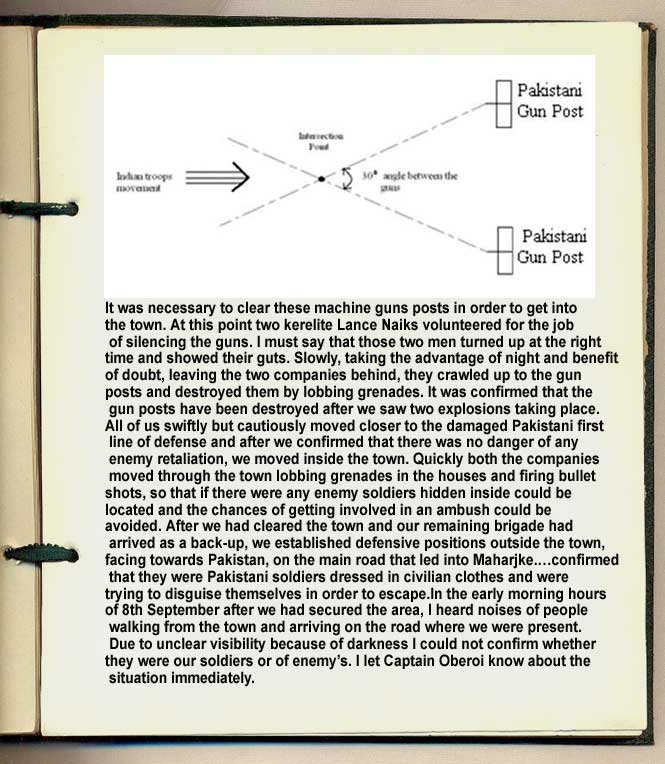
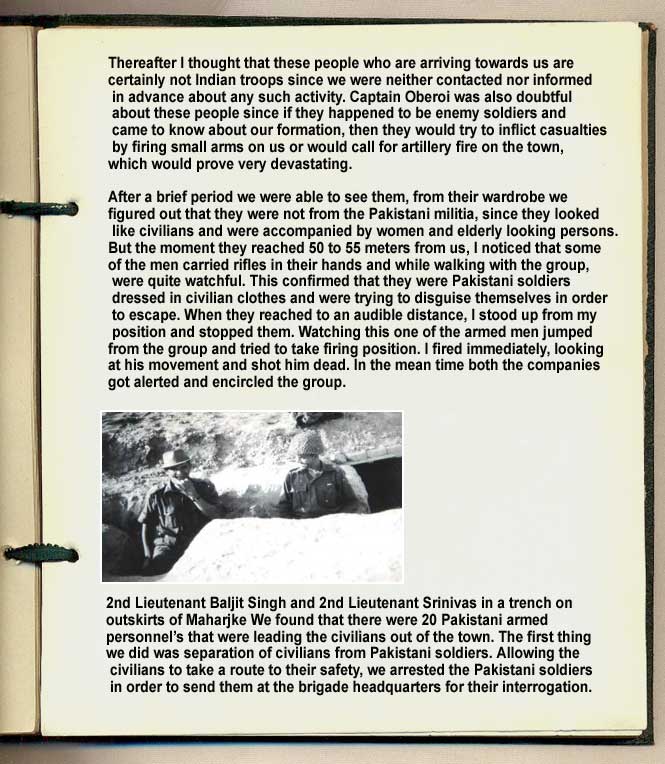
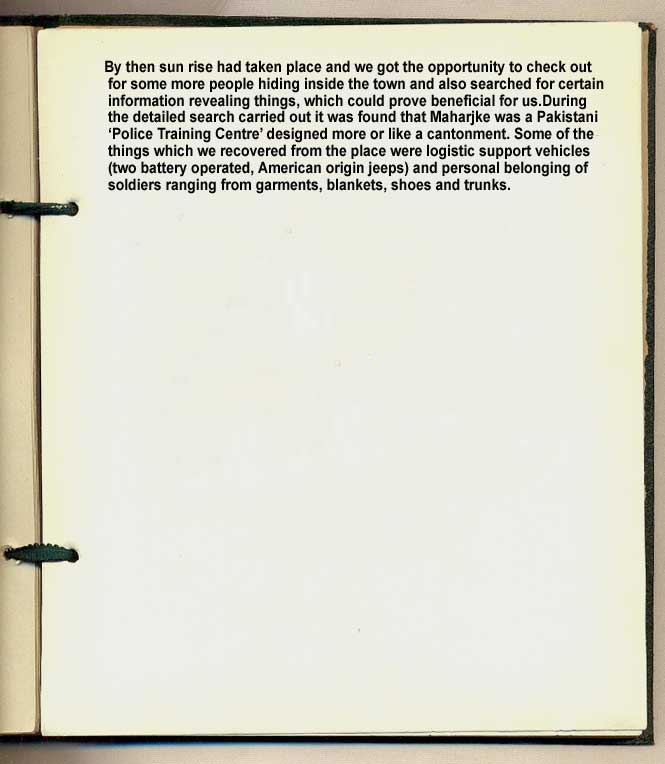
25
February, 2013
Home
>
Spotlights
>
Military & Aerospace
> 1965 War:True Story of 2/Lt Baljit Singh- II
Military & Aerospace
1965 War:True Story of 2/Lt Baljit Singh- II
By
Colonel Baljit Singh
Issue
Net Edition
| Date : 01 Aug , 2012
2nd Lieutenant Baljit Singh and 2nd Lieutenant Srinivas outside
their trench near Phillora
For the whole of 8th and 9th September we did patrolling in the
nearby villages surrounding Maharjke, for identification of
Pakistani soldiers and locating their position. In some of the
villages we identified considerable Pakistani militia
concentrations, who were detailed to engage the inward moving Indian
troops. In order to neutralize such villages, we used the tactics to
block the exit route of the village and called for mortar fire, so
that the shelling of area would cause the enemy concentration to
break up and flee away before they could think of something else.
Likewise approximately 300 Pakistani villages were destroyed by the
entire 6th mountain division put forward on the front of Sialkot
sector. The entire ‘Sakargarh’ district was overrun by the 69th
Infantry Brigade, in which Maharjke was situated and 20 to 30
villages were secured in addition.
The artillery shelling done in response of Pakistani howitzer fire
proved quite effective.
On 10th September we had achieved a firm control over our first
objective, so the senior officials of the brigade were occupied in
further planning of the much needed things with their ‘Army Supply
Core’ counterparts as we had made a vital break through enemy lines
and were not in a mood to retreat under any circumstances. While the
people from medical core were engaged in treating the wounded
soldiers we found that most of the casualties that we received were
mainly due to the shelling which had taken place, when we were
inching our way towards Maharjke through unprotected farms and
because of the machine gun fire. I found out that my batman, who was
crawling just next to me, was killed by one of the bullet shots
fired from those guns. But he was not the only one who faced abrupt
death, there were many more like him who died before we were able to
silence those guns.
The artillery shelling done in response of Pakistani howitzer fire
proved quite effective. Since the fear of a brigade size attack was
more than enough to make the entire town vacant, well before we
reached at its gates. In the late evening when I was on patrolling
duty we heard an echoing sound of armored columns approaching
Maharjke. I thought that these must be the Pakistani tanks since
they were coming from deep inside Pakistan. Nor had we been informed
about any such tank movement by our commanders neither we knew about
any Indian armored formation closer to us. Keeping an eye on the
movement of those armored vehicles I contacted Captain Oberoi who in
turn contacted Lieutenant Colonel Bhattacharya and reported the
matter to him. When he learnt about the fact he too was astonished
and quickly contacted his superiors. It was only then we came to
know that these tanks belonged to the Indian Armored Corps and were
returning from ‘Phillora’.
Such was then the tensed atmosphere in war, which at times becomes
more or less chaotic. While a person is in the battle ground he has
to depend more on his senses than anything else because at last it
is the soldier himself who has to take vital decisions keeping in
mind a lot many things including the responsibility of life of men,
under his command.
As expected our next target was now to capture Phillora. The brigade
commander in accordance with the three battalion commanders had laid
down the immediate plan of action and the same night we started our
travel towards Phillora.
When the tank columns reached closer, I along with my patrol party
went ahead and interrupted them. Learning the fact that we were
Indian soldiers, from one of the tanks a Sikh commander came out and
let us know what had happened in Phillora. He told that Pakistanis
used ‘Blitzkrieg’ tactics to counter our armored regiments.
Blitzkrieg was an effective tactics used in world war-2 by the
Germans for routing the opponent forces in which a combination of
air attack, armored support and artillery cover is provided,
resulting in a strong blow. This tactics can be countered only when
the strength of infantry is quite large. The Indian top brass
however depended on the much older ideology of wave attacks, in
which wave after wave of either infantry or armored regiments would
be thrown on the enemy. The big disadvantage of this way of fighting
is that there is a possibility of lack of proper co-ordination and
heavy casualty.
After we escorted those armored columns to the brigade headquarter
we came to know about one more news which was a bad one. In the
link-up with our brigade they informed that in the early hours of
war the armored regiments were pushed in to halt the Pakistani
advance, well before the mountain divisions had arrived on the
Punjab front. At Phillora the Pakistanis, owing to air support
destroyed an entire column of fourteen tanks, including that of
column’s commander.
As expected our next target was now to capture Phillora. The brigade
commander in accordance with the three battalion commanders had laid
down the immediate plan of action and the same night we started our
travel towards Phillora.
Battle of Phillora
As we started for Phillora, we were accompanied by a tank regiment,
consisting mostly of Sherman and Stuart tanks, to provide armored
support. All of us got mounted on the tanks and began to mentally
prepare for another but much awaited encounter with the enemy.
Phillora was approximately 10 kilometers away from Maharjke. Since
our battalion had already seen action before, so most of the people
were keeping a calm state of mind which was much needed at that
moment.
Many of the soldiers though appeared to be relaxed but somewhere in
the back of their mind had an unfulfilled desire of giving the
Pakistanis their piece of mind.
On 11th September, in the early day hours we reached outskirts of
Phillora. But perhaps the Pakistani Air Observation Post (AOP) had
identified our movement and we were attacked with several rounds of
artillery fire. The moment the fire started we jumped from the tanks
and quickly took defensive positions nearby. The tanks had to be
camouflaged in the fields to prevent them from getting pin-pointed
by the Pakistani Air Observation Post.
After few hours, when the shelling stopped I along with 2nd
Lieutenant Dalal were send by our respective company commanders for
forward patrolling in the enemy area for identification of their
location, manual and material strength. Slowly we creped inside the
town with our columns from different sides only to find out that it
had been already vacated. Probably the initial attack made by the
Indian armored regiments was fierce enough to make Pakistanis run
away.
We came across many name plates outside the houses which indicated
that Phillora was the home of many Pakistani army personals. After
the town was cleared by us we established a few more defensive
positions just outside the town, facing Pakistan so that any counter
attack made by the Pakistani militia could be handled appropriately.
Many of the soldiers though appeared to be relaxed but somewhere in
the back of their mind had an unfulfilled desire of giving the
Pakistanis their piece of mind. For consoling such enthusiastic lads
of mother India, we carried out aggressive patrolling in the
villages surrounding Phillora, since from our experience at Maharjke
we had become aware of the Pakistani tactics of guerilla warfare.
The Pakistani militia was abandoning big towns like Phillora and
took refuge in the close by villages for re-grouping themselves.
We adopted the usual method of clearing such areas. A group of
soldiers would attract the enemy fire from one side, all the exit
routes were blocked and two teams consisting of 3 to 4 soldiers
would lit up the village from behind the enemy or mortar fire was
called upon.
2nd Lieutenant Jacob, 2nd Lieutenant Baljit Singh along with a
fellow officer in a sugar cane field near Phillora
On one such occasion I led a column of soldiers to neutralize a
village, which was reported to be containing Pakistani militia. The
location of that village was such that it was not much easy to get a
clear idea of the enemy hide out. In order to get a better view of
the things I climbed up a tree which was over-looking the village.
The moment I reached a sufficient height, from which the whole
village could be seen, a salvo of bullets were fired at the tree.
Although I had taken a risk but it did not go in vain. I was able to
locate the enemy hide out and by the fire power, which they had
advertised, an idea of their strength was obtained. Guiding the
soldiers to block the exit routes I called for retaliatory mortar
fire and within no time the enemy concentration had been
neutralized.
But as it happens on most occasions that for achieving a goal you
have to give something. Like Maharjke in Phillora too we had
casualties in the form of loss of life. After reaching Phillora we
had secured the area around the town. But this fact in addition of
being known to our superior officials was also known to Pakistanis,
who taking advantage of the concentration of troops use to rain
artillery fire on the town, aiming at us. In one such fire which
took place in the morning hours killed Major Chaudhary, the
commander of Bravo Company. He had just come out of his position for
having a view of the things when Pakistani artillery fire started
and one of the shells exploded just next to him, cutting him down.
Later to fill the void created due to his death, Major Nerula joined
as commanding officer of Bravo Company in the midst of the war.
This was just an example of the ‘anything possible’ situation, which
prevails throughout the war.
1
2
3
==================================================================================
Indian Defence Review
1965 War:True Story of 2/Lt Baljit Singh- II
Military & Aerospace
1965 War:True Story of 2/Lt Baljit Singh- II
By
Colonel Baljit Singh
Issue
Net Edition
| Date : 01 Aug , 2012
2nd Lieutenant Baljit Singh, 2nd Lieutenant Jacob and 2nd Lieutenant
Srinivas plan out the action in a village near Sialkot
There were two more instances when we escaped narrowly. On one of
the occasions of clearing up the Pakistani militia concentration in
the surrounding villages, I formed up a team of one JCO and five
riflemen including one NCO for clearing a nearby village. The
soldiers who by now had neutralized many such re-grouping camps were
aware of the tactics to be used. Though the JCO seemed to be
somewhat nervous but they assured me of carrying out the task with
success. But somehow when they reached near the village they were
unable to maintain the secrecy of their presence and invited enemy
fire upon themselves in which the NCO was injured. When they fell
back to the base camp only then we came to know what went wrong. The
nervous JCO was unable to hold on his nerves and committed a
mistake. He was immediately released from his duty and was sent back
to the headquarter.
This was the second incident of the kind in which the soldiers were
not able to hold their nerves.
Probably this happened since there was no officer in-charge of the
team or perhaps the JCO and neither the soldiers under him were
having the required confidence upon themselves to take ‘on the spot
decisions’. One more factor which was indirectly responsible for
this tragedy was the system to be followed. Since I and 2nd
Lieutenant Dalal were mostly given the tasks of patrolling and
clearing enemy concentration areas, as a result no other officer was
able to get the opportunity of knowing about the things to be taken
care off in such operations. Though we shared inputs and experiences
with other officers of the Companies but there still remains a
difference between listening and performing.
Since I had undertaken patrolling duties continuously for frequent
number of times and 2nd Lieutenant Dalal was deployed elsewhere, so
there was no other officer available to accompany that fateful team.
Moreover the order had been passed on from the battalion headquarter
to Alpha Company, of which I was the second-in-command and for
engaging officers from other companies needed the consent of
respective company commanders, which at that time was although
possible but the response could be predicted well before, from the
kind of attitude of the Company commander. This system was indeed an
evil during war days which still persists till date. As a result
looking at the situation and after consulting with my Company
commander, Captain Oberoi, I had no other option left. But the JCO
had to be made the team leader and coincidently had earlier taken
part in such clearing operations. Probably the habit of working
under guidance or the assumed burden of responsibility and his
over-consciousness might have made him to lose his nerve.
The incident of loosing ones nerve is not very rare. On the contrary
it is more or less very common. It can happen with any one, not
necessarily it happens with lower cadre soldiers but it does happen
with officers. One such incident happened when I, 2nd Lieutenant
Jacob, 2nd Lieutenant Srinivas, 2nd Lieutenant Bhadesra and 2nd
Lieutenant Malik were given the task of securing a particular
stretch of railway line which connected Sialkot with Lahore. We went
at the location which was informed to us with a group of 20
soldiers. We established defensive positions on both sides of the
railway track. As per the information that we had received,
Pakistanis used this rail route for reinforcing their small pockets
which had been broken after Indian advance.
On 28th September 1965 the news of declaration of ceasefire reached
us. For many of the soldiers and officers it was out of the blue.
By the time we had secured the area it was late evening. There was
no sign of any Pakistani movement but our source of information was
coincident enough about the data that was passed on to us. We had to
wait for some more time when finally we heard the sound made by the
boots of soldiers while walking along the railway track. Since we
had been over there for quite a long duration and the visibility had
diminished due to the darkness, so it took some more time for us to
roughly get an idea of the numerical strength of the enemy. We held
on to our rifles and had taken firing positions. The plot was
perfect for ambushing Pakistanis but the only fact which could turn
everything was the number of men on each side. We totaled 25 men,
five officers and twenty riflemen. In order to over-power the enemy
our strength should have been higher than what enemy had. At that
moment this thought perhaps ran down the minds of most of us. I was
mentally prepared to take on the enemy, since the intensive
patrolling done while clearing villages had given me a lot of
expertise in handling Pakistanis. But our group also consisted of
few nervous chaps and a fresher. None of the 2nd Lieutenants with me
at that moment had participated in any such task before.
On the other hand the soldiers allotted to each officer were four.
Hence any hastily taken decision could prove fatal if went wrong.
After sometime when the Pakistanis approached a distance of 100 to
150 meters, we identified them and were just trying to get an
approximate idea of their strength when one of the 2nd Lieutenants
opened fire, without letting any one of us know and along with him
his four soldiers too fired, which alerted the enemy. Within no
time the entire scene got changed. Opening of fire before Pakistanis
came close enough to be surprised, revealed our positions to them.
The atmosphere suddenly became confusing. Now the Pakistanis started
firing on us and the situation was going out of control.
Since I was leading the group it was my responsibility to tackle the
things. In utter chaos many of the men and few of my fellow officers
fell back. Now we were left depleted in strength, totaling 5 to 6
men. The advantage we had at that moment was the idea of location,
we knew the area around us but the Pakistanis being cut-off from
that area had little knowledge of the changes around them.
I quickly dispersed my men to project a larger coverage area. I send
three men to my right side and other two to the left, who were
manning an LMG (Light Machine Gun). Like this we projected a frontal
coverage area of 18 to 20 meters and opened a full force counter
fire. It worked and we saw the Pakistanis retreating back. We
continued to fire till the Pakistanis were out of sight along with
their show-off. This was the second incident of the kind in which
the soldiers were not able to hold their nerves. But this time they
were accompanied by the officers who were leading them. Had the
Pakistanis been more in numbers and called for an artillery fire all
the remaining of us would have been killed. But it is said that when
a person has removed the fear of death or even the fear itself from
his mind, then there is no scope of any kind of fear in his life.
Siege on Sialkot
After almost 10 days of stay in the area around Phillora and
securing several vital enemy installations, we came to know that the
26th Division which had been stationed at Jammu, had positioned
themselves in such a way that a siege could be laid on Sialkot. But
for 69th brigade it appeared as if the war was over, since we hadn’t
received any further orders except of carrying out long patrols and
consolidating our positions.
2nd Lieutenant Baljit Singh and 2nd Lieutenant Srinivas (after
ceasefire) on the outskirts of Sialkot
On one occasion I had undertaken a patrolling duty to identify any
enemy movement in a specified village that lay closer to Sialkot.
With a five men team including myself travelled close to the given
location. Upon reaching there we found that a Gorkha battalion was
deployed facing Sialkot, for blocking any enemy movement in or out
of the town. After talking to them we learnt that the entire town
had been vacated by the Pakistanis fearing a three sided Indian
attack.
In order to mark the presence to Indian troops around Sialkot and as
a memory of 1965, I along with my mean pulled out a milestone, from
the main road that led into Sialkot, which embarked in Urdu stating
“Sialkot 1 Mile”. I feel proud to say that the milestone which was
brought by me from Sialkot still remains, as a prized memento of
Indian Army’s success in the 1965 operation, in the battalion
headquarter of 3rd Madras battalion.
On 28th September 1965 the news of declaration of ceasefire reached
us. For many of the soldiers and officers it was out of the blue.
Also at that time there was civilian outrage against the ceasefire.
By presenting articles, through www.indiandefencereview.com,
related to the operations carried out by the Indian Army, on the
western front during 1965 war, I intend not to question anybody’s
contribution who had participated in that war. But I wish to tell to
our upcoming generations about the significance of this war, which
was termed as the “War of Young Officers” as well as ‘The bloodiest
war fought by the Indian army ever’, not only owing to the high
number of casualties inflicted on the part of the enemy but due to
the quality of leadership shown by young recruits irrespective of
the kind of commission which was offered to them. – Colonel Baljit
Singh.
============================================================================
1965 War:True Story of 2/Lt Baljit Singh- I
By
Colonel Baljit Singh
Issue
Net Edition
| Date : 31 Jul , 2011
2/ Lt Baljit Singh and 2/ Lt Jacob relax before briefing by the
Battalion Commander
The incidents narrated ahead are based on the experience of 2nd
Lieutenant Baljit Singh, 3rd Madras Infantry Battalion, 69th
Infantry Brigade, who had participated in the legendary 1965
Indo-Pak war. The contents are a pen picture of the Indian counter
offensive in the Pakistani Punjab sector, which includes ‘Attack on
Maharjke’, ‘Battle of Phillora’ and ‘Siege on Sialkot’.
It was somewhere in the second week of April 1965 when 69th infantry
brigade, in which I was attached, received the news of Pakistani
misadventure in the Kutch sector of Gujarat state. The senior
officials of the brigade were caught with the trauma of an all out
war with Pakistan.
Every chap was excited and was bubbling with energy as well as
fuming with some amount of anger, over such treacherous act done by
Pakistanis.
In the upcoming days that followed their fear become a reality, when
the whole of the mountain division force was put on an alert. I was
undergoing the ‘Weapon Course’ at Mhow, Madhya Pradesh, when a short
notice was received by me to join back with my battalion, which was
at Dharchula, Uttaranchal, close to Indo-China border.
After the war with China in 1962 a one lakh force was raised under
the banner of ‘Mountain Divisions’, which totaled ten in number.
This force mostly consisted of the officers recruited on a large
scale from the ‘Officers Training Centers’(OTC), established all
over the country after the Chinese invasion, since during those days
there happened to be an acute shortage of officers.
Within a few days I reported at my battalion headquarters of 3rd
Madras, which along with 9th Kumon and 6th J&K Rifles constituted
the 69th infantry brigade. Dharchula is a valley surrounded by peaks
ranging from 10000 to 14000 feet. The route towards Dharchula had to
be traversed through Bariely, Pilibhit and Pithoragarh. The medium
of transportation were mini-buses, since the route was only jeepable
at that time. There was rail route available but only till Tanakpur
which was the ‘rail head’.
Upon my arrival it was learnt that the brigade was on a notice of 4
hours for its move. Every chap was excited and was bubbling with
energy as well as fuming with some amount of anger, over such
treacherous act done by Pakistanis. Most of us were consoling
ourselves that when we were ready for a fight with China, the
Chinese did not show up but now we will surely not leave the
Pakistanis without having faced our wrath.
…as it is said no one can predict future, the moment we reached
Pathankot and our respective battalion and company commanders had
started to work on the strategy for countering Pakistani threat in
Punjab sector, the news of ceasefire arrived, which was sponsored by
the then superpowers.
In the wake of another Chinese misadventure the mountain divisions
used to hold different exercises for getting aware of the topography
and acclimatizing with the high altitude conditions, on the
Indo-China border. Our brigade used to hold an annual exercise in
which we had to march our way through 300 kilometers from Dharchula
to Haldwani. Such an exercise used to happen in the ascending
hierarchy, that is to say first a section level exercise used to
take place, then a platoon size, then a company size and finally the
battalion size drill was performed. The amount of struggle faced by
us while trekking the area during patrolling or when such exercises
were carried out helped in making most of us a true fighting
machine.
Mobilization & Deployment
When the final movement order was received the brigade started to
move out of Dharchula towards the new brigade headquarters at
Pathankot, in Punjab. Since there were not many military transport
vehicles available so most of the mobility was made possible by
hiring civilian trucks and buses. The path which we took to reach
Pathankot in the shortest time possible was through Pithoragarh,
Tanakpur, Katgodam, Bariely, Muradabad, Meerut, Saharanpur and
Ambala. It took us seven days to reach our destination but everyone
was quite happy to see the kind of civilian support that we received
on our way. All the people gathered at every stoppage we took, for
handing over eatables. Many civilians upon watching us used to start
shouting motivational slogans like ‘Victory to Mother India’, ‘Jai
Hind’ and what not.
Such an atmosphere made us determined about the task which we had to
perform. But as it is said no one can predict future, the moment we
reached Pathankot and our respective battalion and company
commanders had started to work on the strategy for countering
Pakistani threat in Punjab sector, the news of ceasefire arrived,
which was sponsored by the then superpowers. Few of us were relieved
of the mental tension developed before a fight but still there were
many who were disappointed for not being able to see action and take
revenge of the breach of faith that Pakistan had done.
2nd Lieutenant Baljit Singh and 2nd Lieutenant Jacob share a light
moment at Battalion Head Quarter
In the mean time when ceasefire was officially declared, we were
able to make up for the lost time. Not only that but we were also
provided training on tanks because in case of emergency one has to
go even beyond his call of duty. I along with few other officers was
explained in detail many aspects of an armored vehicle and we were
given an idea about the fire control system of a tank. The tanks on
which we were trained consisted mostly of world war-2 tanks like the
‘Sherman’ and ‘Stuart ‘light tanks.
Staying for about a month at Pathankot the brigade was finally moved
back to Dharchula. Few of the officers even went on a short leave
straight from Pathankot, when the order to pull back was received.
==================================================================
1965 War:True Story of 2/Lt Baljit Singh- I
By
Colonel Baljit Singh
Issue
Net Edition
| Date : 31 Jul , 2011
2nd Lieutenant Srinivas and 2nd Lieutenant Baljit Singh at Battalion
Head Quarter
Re-mobilization
After we fell back to Dharchula from Pathankot and assumed our
duties, the whole of July and first week of August had passed away.
Many of us continued to think over and over about the skirmish which
had taken place with Pakistan. There were a few who thought that it
was better to sought out matters with Pakistan for once and for all
rather than getting involved in the proxy war game that Pakistan was
playing with us.
May be the almighty listened to our anguish and had blessed us when
in the last week of August, we received a message regarding the
re-mobilization of the entire brigade once again towards Punjab, to
counter the threat of growing Pakistani infiltration near ‘Akhnoor’.
It appeared as if we were being refueled by the enthusiasm to fight,
after hearing the news.
…the need of better transport became a hurdle since there were
hardly any heavy transport vehicles available during those days. But
somehow we were able to reach Ambala as per schedule.
Within couple of hours it was officially declared by our senior
officers about the re-mobilization. The same events happened once
again but this time instead of Pathankot the new destination was ‘Sambha’,
in J&K. Since the things were moving much quickly than before, so we
made Ambala our junction from where the respective battalions or
brigades would move on to take up their positions.
On the way we were being re-grouped at Petrol pumps, in order to
avoid any confusion, as the movement of troops was on a larger scale
and was carried out much swiftly.
Once again the need of better transport became a hurdle since there
were hardly any heavy transport vehicles available during those
days. But somehow we were able to reach Ambala as per schedule. The
69th infantry brigade was instructed to establish their
administrative and support base at Pathankot, while the three
infantry battalions would move close to the international border.
The 3rd Madras battalion was ordered to move towards Sambha and
secure it since there were reports of a Pakistani attack on the
bridge made on river Chenab at Akhnoor. The moment we reached at
Sambha we got the news of Pakistani Air raid on Pathankot in which
the heavy baggage of 69th infantry brigade was lost. Listening to
this every single person of the battalion was enraged because that
baggage which got destroyed in the raid also contained the personal
belonging of the soldiers.
For
next two days our respective company commanders along with the
battalion commanders held on briefings after briefings about the
strategy to carry out the counter attack in Pakistani Punjab sector.
I along with other officers was taken at the forward posts to recce
the international border, so that at the time of assault nothing
goes wrong.
To be continued…
By presenting articles, through
www.indiandefencereview.com,
related to the operations carried out by the Indian Army, on the
western front during 1965 war, I intend not to question anybody’s
contribution who had participated in that war. But I wish to tell to
our upcoming generations about the significance of this war, which
was termed as the “War of Young Officers” as well as ‘The bloodiest
war fought by the Indian army ever’, not only owing to the high
number of casualties inflicted on the part of the enemy but due to
the quality of leadership shown by young recruits irrespective of
the kind of commission which was offered to them. – Colonel Baljit
Singh.
|